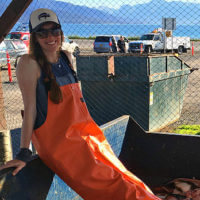Hope College, B.A. Biology
I am from Downers Grove, Illinois, and I spent my time in the Midwest working in large-scale prairie conservation, aquatic toxicology, and four years of undergraduate research focused on parasitic fungi in agricultural grass. I moved to Alaska in 2012 to work in Arctic marine research, and have led offshore environmental data collection in benthic and plankton ecology, ocean acidification, and protected mammal/bird species, but never…. fish. I came to the FAST Lab interested in continuing their research on a fish parasite similar to the parasitic fungus I was fascinated by in college. Since, I have learned that I love being involved with fisheries in science, management, and society.
I am studying “Effects of the Parasite Ichthyophonus (sp.) on Groundfish Growth and Condition”. Ichthyophonus is a genus of parasites infecting 145 fish species to date, in globally distributed fresh and saltwater aquatic systems. It is known to manifest as physical signs that are species-specific but include white nodules on the heart, black patches on the skin, or pus pockets in muscle tissue. Physiological effects range from reduced growth and condition to inhibited swimming stamina.
Ichthyophonus has also been linked to mass die offs in economically important fish stocks. The primary goal of my thesis is to examine Ichthyophonus prevalence in three key commercial species in Alaska (Pacific halibut, Pacific cod, and Alaska pollock) in three Alaskan port towns (Homer, Seward, and Whittier), while examining basic physical factors such as size-at-age and sex. My second objective is to take a close look at how Ichthyophonus affects fish condition in these species by using three assessment tools Bioelectric Impedance Analysis for studying muscle condition, qPCR for quantifying parasite load, histopathology for determining host immune response, and Fulton’s Condition Factor for a traditional weight-length comparison.
Collaborators: Sarah Webster
Related Thesis: Caitlin Grenier
Funding for this work was provided by the Pollock Conservation Cooperative via the Alaska Education Tax Credit Program.

